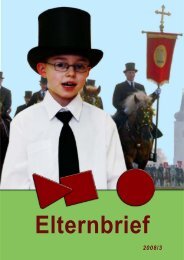Witaj und 2plus - Sorbischer Schulverein e.V.
Witaj und 2plus - Sorbischer Schulverein e.V.
Witaj und 2plus - Sorbischer Schulverein e.V.
Erfolgreiche ePaper selbst erstellen
Machen Sie aus Ihren PDF Publikationen ein blätterbares Flipbook mit unserer einzigartigen Google optimierten e-Paper Software.
Introduction<br />
The purpose of this paper is to provide a<br />
brief description of the work that is currently<br />
being <strong>und</strong>ertaken in Wales to promote the<br />
use of Welsh within families and the raising<br />
of children bilingually. This paper focuses<br />
solely upon the work of Twf, a national project<br />
f<strong>und</strong>ed by the Welsh Assembly Government,<br />
managed by the Welsh Language<br />
Board and run by Iaith Cyf, the Welsh Centre<br />
for Language Planning.<br />
Context<br />
At the turn of the 21 st century, the Welsh language<br />
enjoys a higher status than imagined<br />
possible fifty years ago. According to the<br />
2001 decennial census, there has been a further<br />
gain of some 74,000 Welsh speakers over<br />
the age of 3, since 1991, giving a current total<br />
of some 582,000 Welsh speakers. This amounts<br />
to 20.8% of the population of Wales 1.<br />
Aro<strong>und</strong> 57% (315,000) of Welsh speakers<br />
are reportedly fluent in the language 2. Table<br />
1 gives an overview of the change between<br />
1991 and 2001 in the average percentage of<br />
Welsh speakers according to age group. These<br />
percentages vary significantly from one<br />
part of Wales to another.<br />
TABLE 1: % able to speak Welsh according to age group 3<br />
Age group<br />
3–4<br />
5–14<br />
15–24<br />
25–34<br />
35–44<br />
45–54<br />
55–64<br />
65–74<br />
75 and older<br />
1991<br />
16,2<br />
26,0<br />
17,8<br />
14,1<br />
14,9<br />
16.5<br />
18,4<br />
20,8<br />
25,1<br />
2001<br />
18,8<br />
40,6<br />
24,4<br />
15,9<br />
14,4<br />
14,9<br />
16,4<br />
18,1<br />
21,1<br />
The Earlier<br />
the Better: Promoting<br />
Bilingualism During<br />
Pregnancy<br />
and Immediately<br />
After Birth<br />
As Table 1 indicates, while the proportion of<br />
Welsh speakers over the age of 35 continues<br />
to fall, there has been an increase in the members<br />
of the younger generation (age 3–35)<br />
who are reportedly able to speak the language.<br />
This increase is greatest in the 5–14 age<br />
group which demonstrates the crucial role<br />
Welsh-medium education plays in increasing<br />
the numbers of Welsh speakers. However, as<br />
Fishman’s seminal work on language revitalization<br />
(1991) 4 emphasizes, the promotion<br />
of a minority language within institutions<br />
such as education, government legislation,<br />
the economy and the national media cannot,<br />
of themselves, reverse language shift without<br />
also securing the mechanism of intergenerational<br />
transmission through «the normal,<br />
daily, repetitive and intensely socializing and<br />
identity-forming functioning of home, family<br />
and neighborhood» (1991: 162). Consequently,<br />
there has been considerable concern<br />
in Wales since the 1970’s that, according to<br />
census statistics, there is an inadequate proportion<br />
of young children being brought up<br />
speaking Welsh in the home to ensure the<br />
future vitality of Welsh as a language of the<br />
home, family and community.<br />
The most recent census figures show that the<br />
rate of inter-generational transmission for<br />
3–4 year olds is 82% (3,818) when both<br />
parents report being able to speak Welsh (see<br />
Table 2). However, when only one parent in<br />
1 Welsh Language Board (2007) The Vitality of Welsh: A Statistical<br />
Balance Sheet. www.bwrdd-yr-iaith-org.uk<br />
2 Welsh Language Board (2004)<br />
3 Adapted from Welsh Language Board (2007) The Vitality of Welsh:<br />
A Statistical Balance Sheet. www.bwrdd-yr-iaith-org.uk<br />
4 Fishman, J. (1991) Reversing Language Shift: Theoretical and<br />
Empirical Fo<strong>und</strong>ations of Assistance to ThreatenedLanguages. Clevedon,<br />
Avon: Multilingual Matters.




